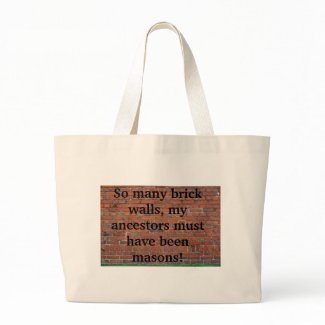My paternal great-grandmother was Mary Quinn ("Grandma Molly"), and to my knowledge - and according to information given me by other relatives - she was always known as Molly. She was born in Brooklyn to Mary Gillan and Hugh Quinn, but though she was supposedly born 22 March 1897, she doesn't appear on the 1900 Federal Census with her family.
The Quinn family is living at 332 Bergen Street in the 10th Ward. The parents are Hugh and Mary, both 33, who have been married 7 years. Their children are Nora, age 5, who was born in December 1895; Anna, age 13, who was born in March 1887; and Helen, age 10 months, who was born in July 1899. (Mary Gillan's brother Mark is also living with them.)
The oddities in this census record are two-fold.
First, there's the presence of Anna. This Anna is old enough to predate the marriage between Hugh and Mary. She's also listed out-of-order, 13 years old, but showing up listed between a 5-year-old and an infant. I asked around the family, and no one had ever heard of an Anna in the family, a sister older than Agnes (aka Nora - figuring that out was its own story!), or a prior marriage for Hugh. Searching for this Anna Quinn, or anyone in her family, on the 1892 NYS Census proved futile. I had no idea who Anna was, or where she'd come from.
Second, there's the absence of Molly. She should be 3 years old. It's hard to imagine why her older and younger sisters are living with their parents, but she's not. No plausible Mary or Molly Quinn shows up in any hospitals, institutions, or other families in the city. My great-uncles - Molly's sons - weren't able to recall any reasons why their mother might not have been living with her parents as a young child. She is listed right where she should be, with her family, on all later federal and New York State census records.
It did occur to me that Anna might not be who she seemed. Children are usually listed in age order, so it seems irregular for 13-year-old Anna to be in the spot of the middle child in the family - the spot that
should have belonged to Grandma Molly. But neither the name nor the age were even in the right ballpark, so I was convinced there was no relationship - except perhaps that of half-sisters - between these two. If one or the other had matched, I might have thought that the entry referred to Grandma Molly, but they did not. And yet I couldn't figure out who Anna was, or where Molly had gone.
So I ignored the questions. After brief searches into Anna and Molly, I stopped looking into them. I ignored the existence of one and the absence of the other, and left the family alone for years.
A couple of months ago, after the 1925 NYS Census was uploaded to Ancestry.com, I located Molly Quinn, and her husband John O'Hara on it with their two young sons. I remembered that I'd never been able to find their marriage record in the
Italiangen.org indexes, even though they were likely married in the early 1920s, a time when the marriages were fairly reliably recorded by the city. I went back and checked the index again, and found that there was a John O'Hara marrying at about the right time, and he was even marrying a Quinn, but her name wasn't Mary.
It was Anna.
I'd seen this entry in the index before and thought nothing of it - Quinns and O'Haras were a dime a dozen in Irish Brooklyn, and my John O'Hara had married a
Mary Quinn. This wasn't her. Right?
I still wasn't seeing what was right in front of me, but I was beginning to have suspicions. I had the date on which her sons had told me Molly was born, but whenever I checked the ItalianGen birth index for a Mary Quinn, I came up empty. I tried again, selecting for just the year 1897, and searching on just the name
Quinn. There, on 22 March 1897, Grandma Molly's birthday, was an entry for an Annie M Quinn. Suddenly, I understood. 13-year-old Anna was 3-year-old Molly. John O'Hara married Molly Quinn when he married Anna Quinn.
I sent away for the birth and marriage records, and was not disappointed.
According to her birth certificate, Annie May Quinn (or Anne May Quinn? or Ann(i)e Mary?) was born 22 March 1897 at 328 Bergen Street, only a couple of doors down from where she would be so confusingly enumerated in the 1900 Census. Her parents were Mary Gillen and Hugh Quinn. He was an engineer. There was no doubt - none whatsoever - that this was Grandma Molly. And that her first name was Annie.
The March 1923 marriage certificate was just as convincing.
Anna M. Quinn was living at the home where Molly had been enumerated with her mother and siblings in the 1920 Census. Her parents are Mary Gillen and Hugh Quinn. John J. O'Hara's parents' names are given, accurately, as John J. O'Hara and Mary King. The witnesses to the ceremony are John's brother Eugene W. O'Hara, and Molly's older sister Agnes Quinn (aka Nora).
From a genealogical perspective, or a research perspective, this is a story about not being an idiot, and about evaluating the information offered by a record for its potential truth without discounting it for not fitting with what you think you already know. From a family perspective, this story is about crazy serendipity, and my Dad winning (or at least not losing) an argument, but not knowing it for 21 years.
The story goes that after I was born, and again after my sister Laura was born, my dad finalized our names, while my mom was recovering, from the short list our parents had created but without her final input. Though we turned out to be remarkably well-named, my mom was insistent, the third time around, that she would be the one to have the final say for their next child. The discussion during her pregnancy was about whether they would name the baby Anna or Molly - Anna, after my mother's grandmother, or Molly, after the aforementioned Grandma Molly, my father's grandmother. My mom pulled rank, and Anna she was named - after Anna Cianciotta Lanzillotto, my mother's maternal grandmother. For her entire life, we had known that though my dad had wanted to name her after Grandma Molly, he had not prevailed, and so Anna had her maternal great-grandmother's name
and not her paternal great-grandmother's name. The summer that my sister Anna turned 21, I got to call them all up with these papers in hand and tell them all that they had made the right choice in naming her Anna. Because actually, those 2 grandmothers my parents wanted to honor when they named my sister?
They were both named Anna.
















